Capicola Recipe
This post may contain affiliate links. See my disclosure policy.
Succulent, superbly seasoned and flavorful, this easy baked Capicola recipe will take your Italian subs, sandwiches, pizza and snacking to a new level! This homemade capicola is easy to make and your efforts will be amply rewarded – it’s sure to become a favorite!
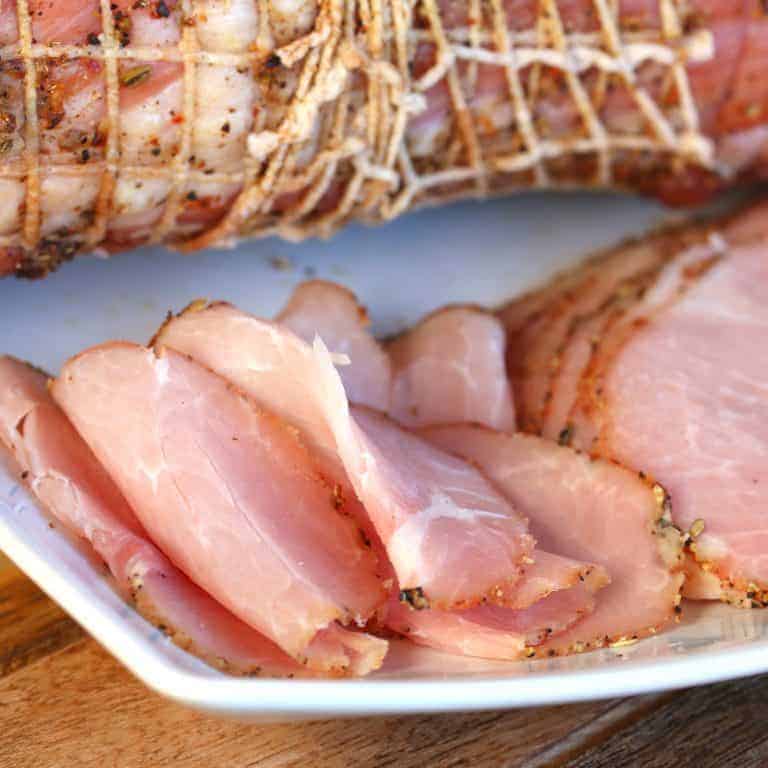
Do you enjoy a good sandwich from time to time? I mean a really good sandwich filled with succulent, high quality seasoned meat? Then you’ve GOT to make this baked Italian Capicola! And if you’ve always dreamed of making your own charcuterie but have either felt too intimidated or were put off by all the special equipment or all the work involved, this fabulous homemade capicola is for you! This is charcuterie-making that is easy, non-intimidating and thoroughly delicious!
What is Capicola?
Capicola (also known as capocollo) and coppa (more on that below) are both Italian charcuterie standards and use the same cut of pork. This specific cut of meat is highly marbled and comes from the neck of the pig (known as the coppa in Italy) and is selected because of it’s a near perfect ratio of 30% fat to 70% lean. This cut is commonly cooked/baked as well as dry-cured to create two different forms of highly popular charcuterie. This recipe is for baked capicola and is inspired by Olympic Provisions’ version.
What is Coppa?
Coppa (named after the cut of meat) is the dry-cured version of capicola. The meat is prepared in a special brine and hung to dry for approximately 2 months depending on its size in a temperature- and humidity-controlled environment where it becomes dry-cured. The coppa is then sliced very thinly (similar to prosciutto). The flavor is complex and flavorful, the texture delicate and almost melt-in-your mouth. Below is a dry-cured coppa I made a few months ago.
Today I’m sharing the cooked (not dry-cured) version of coppa: Capicola. The term capicola is often used interchangeably to also refer to the dry-cured version, so it can be a little confusing. We’re going to use the term capicola throughout the rest of this tutorial to refer to the cooked version.
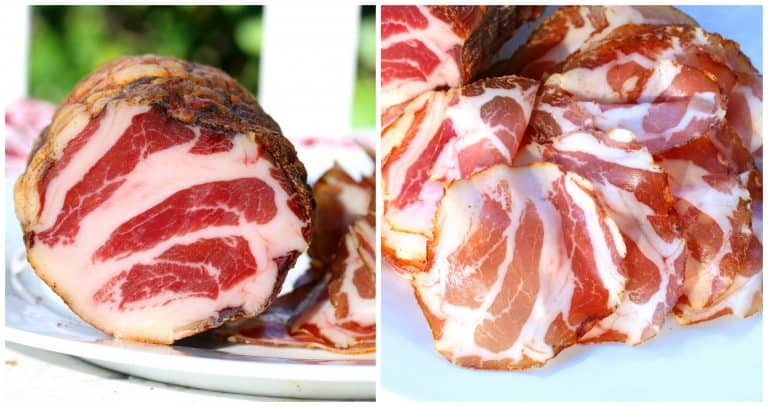
What You’ll Need
For this tutorial I’m also using a regular pork loin in the event that you have trouble locating the traditional coppa cut of pork (it can be difficult to find butchers who are knowledgable in European cuts, especially less common ones used for specialty charcuterie). It lacks the marbling of the traditional coppa cut and so won’t be as tender/moist but it still thoroughly delicious.
The ingredients for making capicola are minimal and (if you’re just using pork loin) you only need two items you normally may not have in your kitchen: Pink curing salt and size 24 meat netting. The pink salt helps the meat retain its appetizing pink color (instead of just looking like a brownish-gray pork roast once it’s cooked) and the net helps the meat retain its shape while cooking so you can get those beautiful slices.
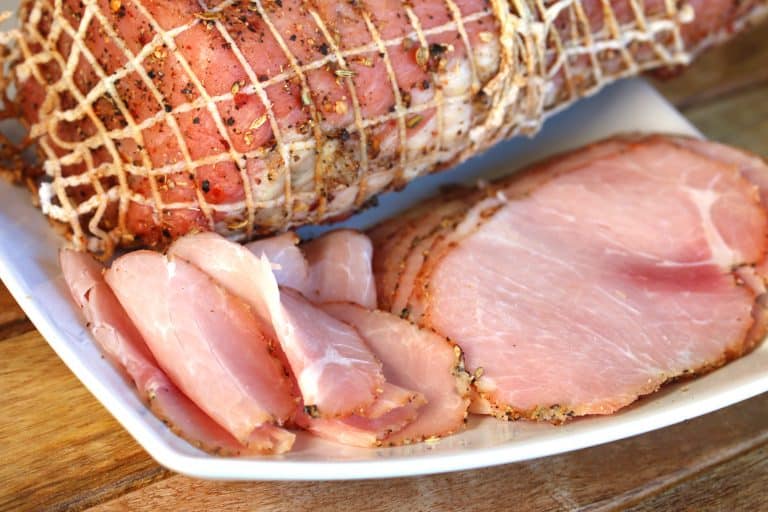
The process is very easy, there’s frankly very little that could go wrong, and your friends and family will think you’re an absolute pro! Make some delectable Italian subs using this capicola, add some cheese and some homemade Giardiniera if you like (amazing stuff!), and you’ve got one seriously delicious sandwich! It’s also fabulous on pizza.
Making your own coppa is also extremely cost-effective. Coppa in the specialty deli (if you’re lucky enough to find it) comes with a hefty price tag. You can make your own at a fraction of the cost.
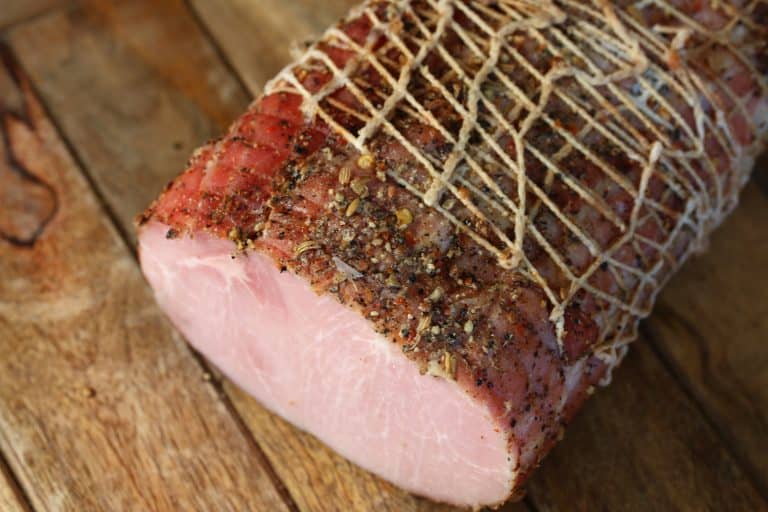
Homemade Capicola Recipe
Let’s get started!
First we’re going to make the cure for our pork. Place the sea salt, sugar, red pepper flakes and pink curing salt in a coffee/spice grinder or use a mortar and pestle to grind them. (It is essential that the pink salt is evenly distributed in the rub.)
Place the pork in a large bowl or on a work surface and massage the rub into the pork, making sure to get every nook and cranny.
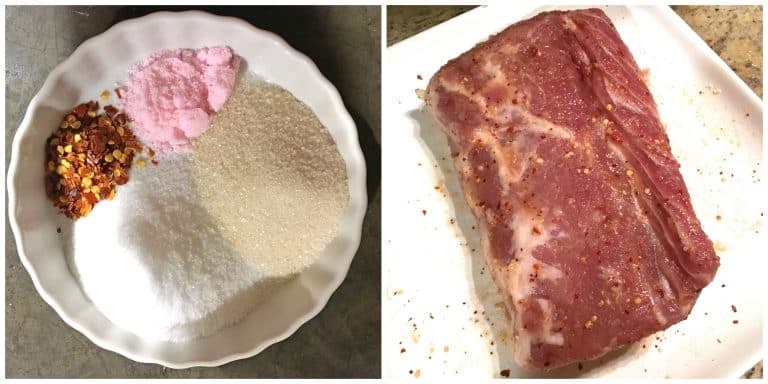
Wrap the pork tightly in plastic wrap and refrigerate it for 5 days. After 5 days flip it over so the bottom side is up and refrigerate it for another 5 days.
After 10 days unwrap the meat. It will be firmer to the touch. Thoroughly rinse it under cold water to remove all the spices and set it aside while you prepare the final rub.
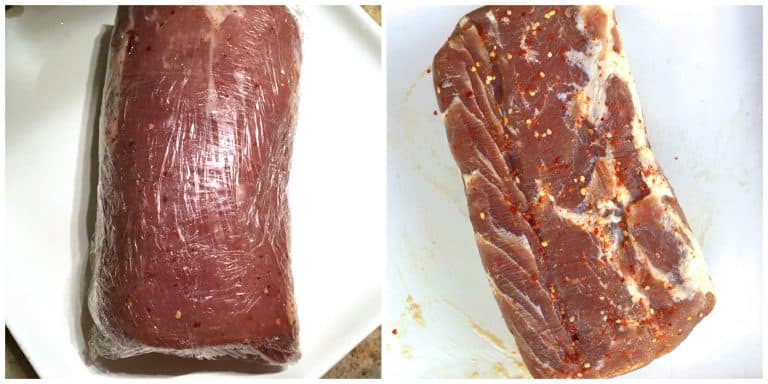
To make the rub, place the fennel seeds, coriander seeds, anise seeds, red pepper flakes and black peppercorns in a coffee/spice grinder or use a mortal and pestle to grind the spices until you get a coarse rub. Lightly blot the pork with a paper towel.
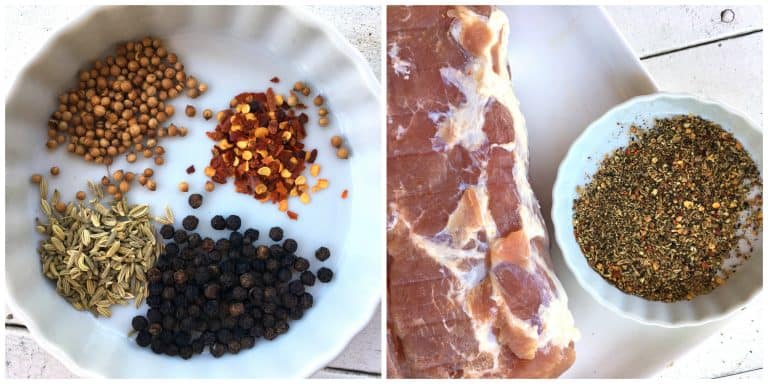
Spread the rub out onto a plate or work surface and roll the pork in it, coating all sides. Use up all the spice rub to coat the meat.
Next you’ll need a #24 netting roll. Cut a piece of netting off the roll that is a few inches longer than your capicola.
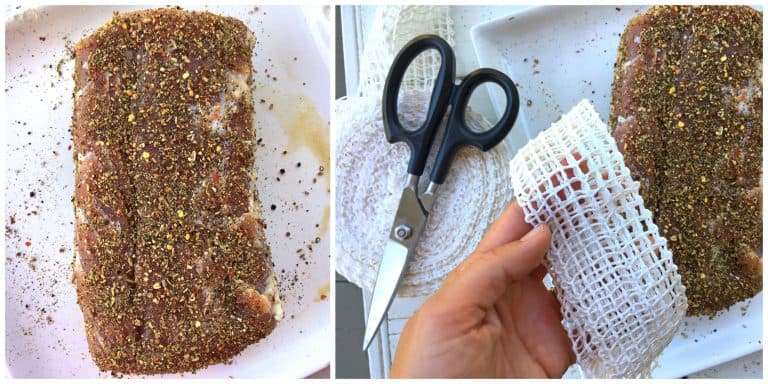
Stretch the netting and feed the capicola through it (unless you have a ham-stuffing funnel, it’s easiest to do this with two people).
Preheat the oven to 250 degrees F. Fill a pan up with water and place it on the middle rack of the oven. This will create humidity as the pork cooks to keep the pork moist. Place the capicola on a roasting pan fitted with a wire rack and place the pan on the top rack of the oven. Cook the capicola for 1 hour, then turn the pork over so the bottom side is up and bake it for another hour or until the internal temperature reaches 145-150 degrees F. Don’t overcook or the meat will be dry.
BE PATIENT, IT’S NOT READY TO EAT YET! Remove the capicola, place it on a plate and refrigerate uncovered for 4 hours.
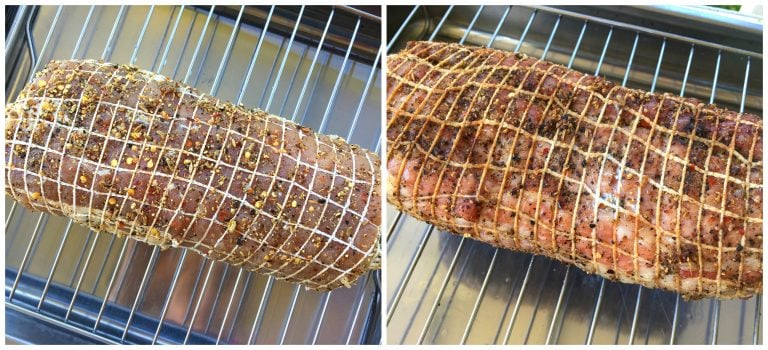
At that point your homemade Italian capicola is ready to eat! Slice it thinly and enjoy it on your sandwiches, pizzas or eaten on its own!
If you want very thinly sliced meat like the deli meat you buy in the store, you’ll need a meat slicer like this Chef’s Choice Electric Meat Slicer.
We love to make Italian subs by adding some capicola, cheese and homemade Giardiniera – it’s out of this world!
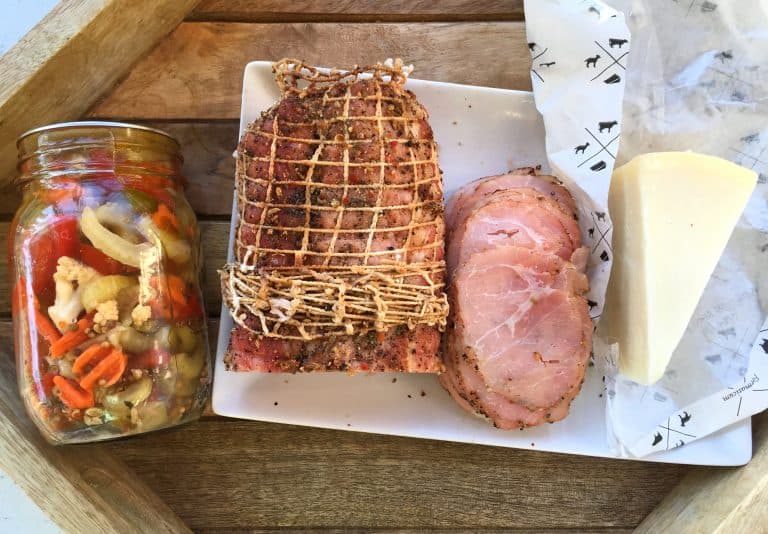
To store, keep it wrapped tightly in plastic wrap in the refrigerator where it will keep for up to 3 weeks.
Sliced capicola can also be frozen for up to a couple of months.
Enjoy!
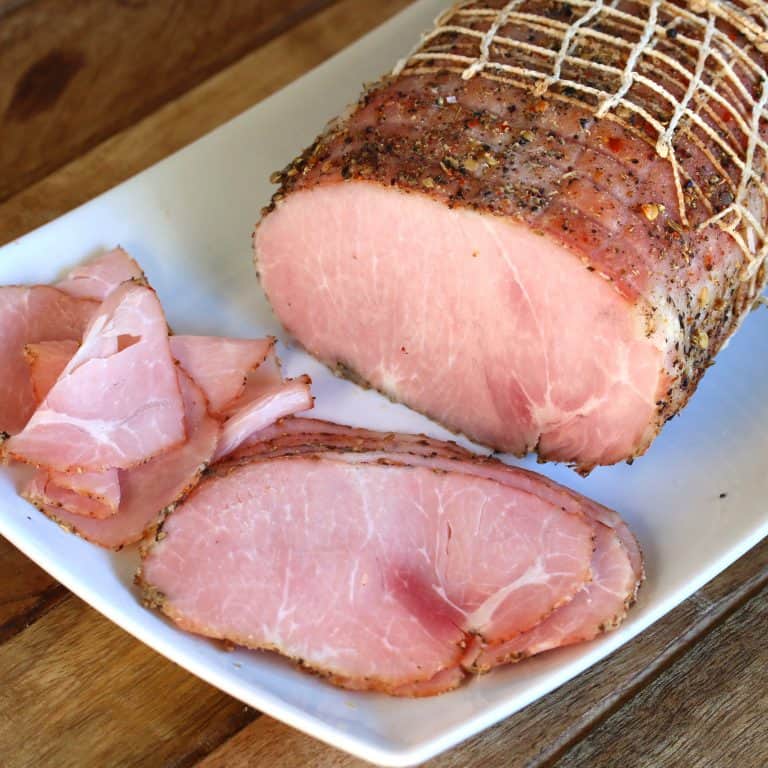
For more adventures in homemade charcuterie be sure to try my:
- Smoked Ham
- How to Make Bacon
- Capicola
- Porchetta
- Gravlax
- German Bratwurst
- Bangers
- Pork Rillettes
- Smoked Cheddar Sausages
- Breakfast Sausage Links
- Italian Sausage
Save This Recipe
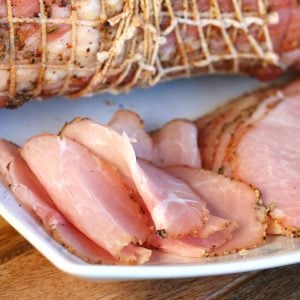
Capicola Recipe
Ingredients
- For the Curing Rub:
- 3 pounds pork coppa or pork loin (coppa is the traditional and preferred cut (we highly recommend it if you can get one from your butcher), see blog post for description)
- 2 1/2 tablespoons sea salt
- 2 tablespoons sugar
- 1 teaspoon crushed red pepper flakes
- 1 teaspoon curing salt #1 (aka Prague powder) (this is essential for maintaining the pink color of the meat as opposed to brown/gray once it’s cooked)
- For the Seasoning Rub (feel free to tweak according to preference):
- 1 tablespoon coriander seeds
- 1 tablespoon fennel seeds
- 1 1/2 teaspoons black peppercorns
- 3/4 teaspoons anise seeds
- 1/2 teaspoon red pepper flakes
- You’ll also need:
- size 24 meat netting
Instructions
- To make the cure, place the sea salt, sugar, red pepper flakes and pink curing salt in a coffee/spice grinder or use a mortar and pestle to grind them. (It is essential that the pink salt is evenly distributed in the rub.)Place the pork in a large bowl or on a work surface and massage the rub into the pork, making sure to get every nook and cranny.Wrap the pork tightly in plastic wrap and refrigerate it for 5 days. After 5 days flip it over so the bottom side is up and refrigerate it for another 5 days.
- After 10 days unwrap the meat. It will be firmer to the touch. Thoroughly rinse it under cold water to remove all the spices and set it aside while you prepare the final rub.To make the rub, place the fennel seeds, coriander seeds, anise seeds, red pepper flakes and black peppercorns in a coffee/spice grinder or use a mortal and pestle to grind the spices until you get a coarse rub. Lightly blot the pork with a paper towel.Spread the rub out onto a plate or work surface and roll the pork in it, coating all sides. Use up all the spice rub to coat the meat.Next you'll need a #24 netting roll. Cut a piece of netting off the roll that is a few inches longer than your capicola.Stretch the netting and feed the capicola through it (unless you have a ham-stuffing funnel, it's easiest to do this with two people).
- Preheat the oven to 250 degrees F. Fill a pan up with water and place it on the middle rack of the oven. This will create humidity as the pork cooks to keep it moist. Place the pork on a roasting pan fitted with a wire rack and place the pan on the top rack of the oven. Cook the capicola for 1 hour, then turn the capicola over so the bottom side is up and bake it for another hour or until the internal temperature reaches 145-150 degrees F. Don't overcook or the meat will be dry.Be patient, it's not quite ready yet! Remove the capicola, place it on a plate and refrigerate uncovered for 4 hours.
- At that point your homemade Italian capicola is ready to eat! Slice it thinly and enjoy it on your sandwiches, pizzas or eaten on its own! (For professional looking deli meat slices, use an electric meat slicer.) To store, keep it wrapped tightly in plastic wrap in the refrigerator where it will keep for up to 2 weeks.The sliced capicola can also be frozen for up to a couple of months.
Nutrition
Originally published on The Daring Gourmet March 6, 2019 / Recipe inspired by Olympia Provisions



















I’m living in Mexico and haven’t been able to locate Prague powder/curing salt yet. Other than color what is the effect if I skip the curing salt? I’m going to try it and post Results later.
Hi Charlie, Prague powder also inhibits the growth of harmful bacteria but that aspect is more important for dry-cured meats or meats that are smoked low and slow. But in the case of this capicola it mostly serves the purpose of maintaining a pleasant color and you can omit it if you can’t find it.
Hi kimberly,
I just finished making your coppa recipe and I have to say that this recipe is fantastic! Everyone that has tried it says it’s wonderful!! I will definitely be making this again but will be making more then one next time. I followed your dry brine , I don’t even think I will bother with trying a wet brine! Nice job!
Fantastic, Marsha, I’m so glad you enjoyed it, thank you for the feedback!
Now 5 days in the fridge. I used tenderquick because I could not find prague powder locally. Tenderquick instructions say 1tbsp per pound, so I am not sure of the ratio of salt to tender quick. My first one I used all the salt in the recipe plus a tbsp of tenderquick. Started a new one today and used 2 tbsp of tenderquick and half the salt. So we’ll see. I hope both are edible.
Hi Kimberly, I am about ready to try your recipe and I had a question for you, have you ever tried a wet brine instead of a dry brine? I was just curious if that would work. Thank you and I can’t wait for my finished product. Thank you for the recipe.
Hi Marsha, yes, you can use a wet brine if you prefer. Let us know how it goes if you give that a try!
Hello,
Can I use pink Himalayan salt instead of sea salt?
Hi Maritza, as a substitute for the sea salt yes, but not as a substitute for the pink curing salt as they are two entirely different things.
I like how it’s implied that professional chefs could use a gas powered meat slicer.
Think I can do this on my smoker? Tomorrow the 10 days curing will be up…
Absolutely, Danica! The key is low and slow.
Can you cure in the fridge longer than 10 days? I wanted to start it before going out of town but won’t be back to cook it until 15 days.
Hi Adriana, yes you can but it may slightly increase the saltiness – I don’t think it will be “too” salty though.
I am so excited to make this recipe this weekend. Just a quick question, it may be a dumb one too, but can you use normal pink himalayan salt instead of Prague Powder or are they different things?
Thanks
Jil
Hi Jilda, yes they’re two totally different things. Prague powder is just colored pink so you don’t confuse it with salt.
Followed your directions to the letter, only fault I found with this recipe is I sould have made 2, I cooked it Saturday and I might have a 2 inch piece left today. My 4 year old grandson could not stop eating it yesterday and had to spend the day with me today so he could have more for lunch. 10 people can’t be wrong they all loved it, I shared with family 84 years to 4 years old, they could not believe I made it. Now I will be starting another this week. Mine was extremely moist, not dry at all, and so flavorful, just the right amount of spice. Thank you for yet another winner Kimberly I don’t know how you ever came up with this but it is pure perfection, thank you!
Sue, I’m so happy you shared this with your family and that it was such a big hit. As always, thanks so much for taking the time to leave feedback! Yours, Kimberly
Hi Kimberley
I’m so excited and happy to have found this recipe. Thank you.
The loin was prepared last night and is in fridge, I noticed some juice in bottom of plastic wrapping. Us this normal?
Hi Jan, that’s totally normal. Happy roasting!
how can I substitute the curing salt with Morton tender quick?
Hi Maryann, I haven’t used tender quick so I’m not sure. That’s a great question though and perhaps one of our readers will be able to chime in.
Cooked mine on Thursday, after 4 hours chill in fridge I sliced it thinly with my boning knife.
Absolutely delicious!!
Flavorfull tender with a nice heat level. We have eaten it plain and in a sandwich, delicious both ways. Considering this is a pork loin it was still very tender.
We enjoyed it more than the commercial product.
Thank you Kim for sharing this great recipe!!
Jim & Doris☺
Thank you, Jim and Doris, I’m so thrilled you both enjoyed it!
Hi Kimberly
I plan to make the Italian capicola,can I freeze half of the completed ham unsliced rather than sliced.
thanks
Jim
Hi Jim, I haven’t tried it but I don’t see why not.
I will let you know how it turns out, in several months.
Kim:
Great, will be waiting.
Tom
Kim:
Looks like a great recipe. I would be more interested in your dry aged one.
Tom
Thanks, Tom, it’s coming :) Just started another dry-cured coppa four days ago. My 8 year old son saw me prepping it and said, “oh mom, you’re making that meat that I love!” I had to laugh out loud. Then my 6 year old daughter came in and also expressed enthusiasm. Raising a couple of foodies here ;)